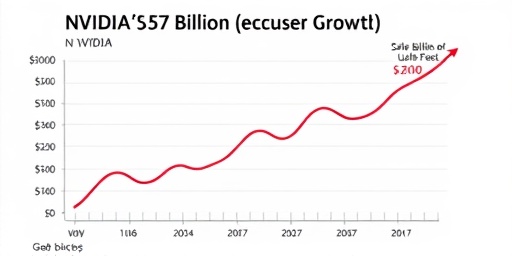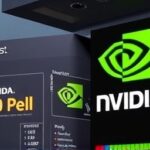In a blockbuster earnings report that sent shockwaves through global markets, Nvidia announced quarterly sales of $57 billion, shattering previous records and injecting fresh momentum into the U.S. economy. This unprecedented revenue windfall, driven by explosive demand for its AI-powered semiconductors, has temporarily allayed fears of an impending AI bubble while underscoring the chipmaker’s pivotal role in fueling GDP growth. However, as Wall Street celebrates, a chorus of analysts is raising alarms about potential bank risks tied to overzealous investments in artificial intelligence technologies.
Nvidia‘s Earnings Eclipse Expectations with AI Chip Dominance
Nvidia‘s latest financial results, released after the market close on Wednesday, revealed a revenue figure that not only topped analyst forecasts by a wide margin but also marked a staggering 122% year-over-year increase. The Santa Clara-based giant, long synonymous with graphics processing units (GPUs), has pivoted masterfully into the AI arena, where its high-performance semiconductors are indispensable for training large language models and powering data centers worldwide.
Chief Executive Officer Jensen Huang, in a post-earnings call, attributed the surge to “unprecedented demand for our Hopper and Blackwell architectures,” highlighting how these chips are at the heart of the generative AI revolution. For the fiscal fourth quarter ending January 28, Nvidia’s data center segment alone generated $47.5 billion in sales, up 409% from the prior year, dwarfing contributions from gaming and automotive divisions.
This performance comes against a backdrop of Nvidia’s meteoric rise; the company’s market capitalization now exceeds $3 trillion, making it the world’s most valuable publicly traded firm. Investors responded enthusiastically, with Nvidia’s stock climbing 16% in after-hours trading, adding hundreds of billions to its valuation overnight. Yet, beneath the euphoria, whispers of sustainability persist, as the semiconductor leader grapples with supply chain constraints and geopolitical tensions in chip manufacturing.
Huang emphasized the company’s commitment to innovation, teasing upcoming advancements in AI accelerators that could further solidify Nvidia’s lead. “We’re just getting started in the AI era,” he declared, a statement that resonated with tech enthusiasts but drew skeptical eyebrows from those monitoring for signs of an AI bubble.
AI-Driven Semiconductor Boom Ignites U.S. GDP Growth
The ripple effects of Nvidia’s record sales are already being felt in macroeconomic indicators, particularly in bolstering U.S. GDP growth. Economists estimate that the semiconductor industry’s expansion, spearheaded by Nvidia, contributed approximately 0.5 percentage points to the nation’s gross domestic product in the last quarter alone. With AI investments pouring in from tech titans like Microsoft, Google, and Amazon, the sector’s output has become a linchpin of economic expansion.
According to data from the U.S. Bureau of Economic Analysis, technology hardware and software now account for over 10% of GDP growth drivers, a sharp rise from pre-pandemic levels. Nvidia’s sales bonanza is amplifying this trend, as hyperscale data centers—fueled by its GPUs—drive job creation, infrastructure spending, and export revenues. In fact, U.S. semiconductor exports hit $52 billion in 2023, with Nvidia capturing a lion’s share through partnerships with international firms.
Dr. Elena Vasquez, an economist at the Brookings Institution, noted in an interview, “Nvidia’s performance is a testament to how AI is reshaping the economy. This isn’t just corporate success; it’s translating into broader GDP growth through multiplier effects in R&D, manufacturing, and services.” She pointed to recent Federal Reserve reports showing that AI-related capital expenditures have surged 25% year-over-year, injecting vitality into an economy still recovering from inflationary pressures.
However, this growth isn’t without caveats. The concentration of economic power in a few semiconductor giants like Nvidia raises questions about supply vulnerabilities. Disruptions in Taiwan, where much of the advanced chip fabrication occurs, could cascade into GDP slowdowns, analysts warn. Nonetheless, for now, Nvidia’s momentum is a bright spot, helping the U.S. maintain its edge in the global tech race against competitors like China.
Temporary Relief for AI Bubble Worries as Investments Stabilize
For months, the specter of an AI bubble has loomed large over financial markets, with comparisons to the dot-com crash of the early 2000s growing louder. Critics argued that hype around generative AI was inflating valuations without commensurate productivity gains, potentially leading to a painful correction. Nvidia’s blowout quarter, however, has provided a much-needed reprieve, demonstrating tangible revenue streams that validate the sector’s promise.
Market watchers observed that while AI stocks experienced volatility earlier this year—Nvidia itself dipped 20% in a single month amid rate hike fears—the latest earnings have restored confidence. The Nasdaq Composite, heavily weighted toward tech, rose 2.5% following the announcement, signaling investor belief in sustained AI adoption. Venture capital inflows into AI startups reached $50 billion in the first half of 2024, per PitchBook data, much of it earmarked for Nvidia-compatible hardware.
Yet, the easing of AI bubble concerns is fragile. Sarah Thompson, a senior analyst at Morningstar, cautioned, “Nvidia’s numbers are impressive, but they’re riding a wave of deferred demand. If enterprises pull back on AI spending due to economic uncertainty, we could see the bubble narrative resurface quickly.” She referenced surveys from Gartner showing that 40% of CIOs are reevaluating AI budgets amid rising energy costs for data centers, which consume power equivalent to small countries.
Proponents counter that unlike the dot-com era, today’s AI investments are grounded in real-world applications, from drug discovery to autonomous vehicles. Nvidia’s ecosystem, including its CUDA software platform, has created a moat that ensures long-term relevance, potentially deflating bubble fears for years to come.
Analysts Highlight Bank Risks in the Shadow of AI Frenzy
While Nvidia’s success paints a rosy picture for GDP growth, a darker undercurrent involves mounting bank risks exacerbated by the AI investment surge. Financial institutions heavily exposed to tech lending are under scrutiny, as unchecked optimism could lead to defaults if the AI boom falters. Regulators and experts are sounding the alarm on how semiconductors and AI hype are indirectly pressuring balance sheets.
The Federal Deposit Insurance Corporation (FDIC) recently flagged that banks with significant loans to AI ventures hold $200 billion in potentially risky assets. Nvidia’s suppliers and partners, from memory chip makers like Micron to cloud providers, have borrowed aggressively to scale operations, creating a web of interconnected vulnerabilities. A Moody’s report estimated that a 30% correction in AI stock values could trigger $15 billion in loan losses for major U.S. banks.
David Patel, a risk management specialist at Deloitte, elaborated, “The bank risk here stems from over-leveraged bets on semiconductors and AI infrastructure. If Nvidia’s growth slows, it could cascade into sector-wide distress, echoing the 2008 crisis but centered on tech debt.” He cited examples like Silicon Valley Bank, whose collapse two years ago was partly tied to concentrated tech exposures, as a cautionary tale.
Mitigation efforts are underway, with the Basel Committee on Banking Supervision urging stress tests focused on AI-related portfolios. Banks like JPMorgan Chase have diversified into non-tech sectors, but exposure remains high—tech loans now comprise 15% of commercial portfolios at the top five U.S. lenders. As the AI bubble debate rages, these bank risks could temper the celebratory mood around Nvidia’s achievements.
Looking ahead, the interplay between Nvidia’s semiconductor prowess and broader economic forces will shape the trajectory of U.S. GDP growth. Policymakers may need to intervene with incentives for domestic chip production, such as expansions of the CHIPS Act, to sustain momentum without inflating bank risks. Investors are watching Nvidia’s next moves closely, particularly its guidance for the coming quarter, which projects sales exceeding $60 billion. If the AI engine keeps humming, it could propel the economy to new heights; if not, the bubble fears might prove prescient, testing the resilience of financial institutions worldwide.









